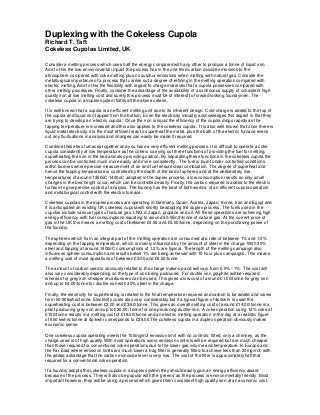
Duplexing with the cokeless cupola
- 1. Duplexing with the Cokeless Cupola Richard T. Taft Cokeless Cupolas Limited, UK Consider a melting process which uses half the energy compared with any other to produce a tonne of liquid iron. Add to this the low environmental impact the process has in the one third carbon dioxide emissions to the atmosphere compared with coke melting plus no sulphur emissions when melting with natural gas. Consider the metallurgical importance of a process that carries out a degree of refining in the melting operation compared with electric melting. Add to this the flexibility with regard to charge materials that a cupola possesses compared with other melting processes. Finally, consider the advantage of the availability of a continuous supply of consistent high quality iron at low melting cost and surely this process must be of interest to forward looking foundrymen. The cokeless cupola in a duplex system fulfils all the above criteria. It is well known that a cupola is an efficient melting unit due to its inherent design. Cold charge is added to the top of the cupola and liquid iron tapped from the bottom. Even the electricity industry acknowledges this aspect in that they are trying to develop an 'electric cupola'. Once the iron is liquid the efficiency of the cupola drops rapidly as the tapping temperature is increased and this also applies to the cokeless cupola. It is also well known that once there is liquid metal electricity it is the most efficient way to superheat the metal, plus the bath of the electric furnace evens out any fluctuations in analysis and changes can easily be made if required. Combine these two furnaces together and you have a very efficient melting process. It is difficult to operate a coke cupola consistently at low temperature as the coke is carrying out three functions of providing the fuel for melting, superheating the iron in the bed and also providing carbon. By separating these functions in the cokeless cupola the process can be controlled much more easily and more consistently. The fuel is burnt under controlled conditions within burners where precise measurement of air and fuel ensure ideal combustion. The degree of superheat and hence the tapping temperature is controlled by the depth of the bed of spheres and at the deliberately low temperatures of around 1350oC-1400oC adopted in the duplex process, a low consumption results so only small changes in the bed height occur, which can be controlled easily. Finally, the carbon required is added to the electric furnace to give precise control of analysis. The foundry has the best of both worlds, of an efficient cupola operation and metallurgical control with the electric furnace. Cokeless cupolas in the duplex process are operating in Germany, Spain, Austria, Japan, Korea, Iran and Egypt and it is anticipated an existing UK cokeless cupola will shortly beadopting the duplex process. The fuels used in the cupolas include various types of natural gas, LNG in Japan, propane and oil. All these operations are achieving high energy efficiency with fuel consumptions equating to around 50-55m3/tonne of natural gas. At the current price of gas in the UK this means a melting cost of between £4.50 and £5.50/tonne, depending on the purchasing power of the foundry. The spheres which form an integral part of the melting operation are consumed at a rate of between 1% and 1.5% depending on the tapping temperature, which is mainly influenced by the amount of steel in the charge. With 30% steel and tapping at around 1400oC consumptions of 1.2% are typical. The length of the melting campaign also influences sphere consumption and results below 1% are being achieved with 10 hour plus campaigns. This means a melting cost of most operations of between £5.00 and £6.50/tonne. The amount of carbon used is obviously related to the charge make-up and will vary from 0.5% - 1%. The cost will also vary considerably depending on the type of iron being produced. For ductile iron graphite will be required, whereas for grey iron cheaper recarburisers can be used, This gives a low cost of around £1.00/tonne for grey iron and up to £4.00/tonne for ductile iron with 30% steel in the charge. Finally, the electricity for superheating is related to the final temperature required and carbon to be added and varies from 50-90kwhrs/tonne. Electricity costs also vary considerably but if a typical figure of 4p/kwhr is used the superheating cost is between £2.00 and £3.60/tonne. This gives an overall melting cost of around £14.00/tonne in a plant producing grey iron and up to £20.00/ tonne for one producing ductile iron. A coke operation using 12% coke at £150/tonne results in a melting cost of £18.00/tonne and an electric melting operation in the day at a realistic figure of 650 kwhrs/tonne at 4p/kwhr corresponds to £26.00.The cokeless cupola in a duplex operation obviously makes economic sense. One cokeless cupola operating meets the 100mg/m3 emission limit with no controls, fitted, only a chimney, as the charge used is of high quality.With most operations some emission controls will be required but are much cheaper than those required for conventional coke operations due to the lower gas volume and temperature. In Europe and the Far East where emission limits are much lower a bag filter is generally fitted to achieve less than 20mg/m3, with the added advantage that the carbon monoxide level is very low. The cost of the filter is approximately half that required for a conventional coke operation. If a foundry adopts the cokeless cupola in a duplex system they should easily gain an energy efficiency award because of the process. They will also be popular with the 'greens' as the process is environmentally friendly. Most important however, they will be using a process which gives them consistent high quality iron at an economic cost.